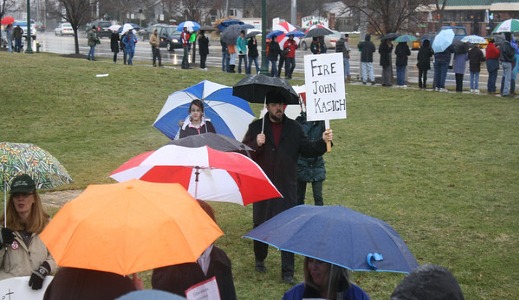
Ohio’s highly-skilled workers have shown a keen ability to produce products and services for the needs and use of our state’s consuming public. Our work-force has an amazing 66.9 percent increase in productivity over the last 25 years (1979 to 2014). Having produced so much more product for every hour worked, one would expect that wages and benefits for these workers would also increase.
Not so! Income for Ohio workers actually dropped over this period, falling behind the income level in many states, and well behind the national average.
Instead of an increase in income for the workers who have produced the massive wealth created by their labor over the last 25 years, those in the top 1percent income bracket, the billionaire corporate owners and financiers, have seen a 70.7 percent increase in their income. (State of Working Ohio/Policy Matters Ohio).
Working families have not only suffered from falling income, but nearly 20 percent of the available workforce in Ohio have given up looking for jobs that have not been available for these many years. Add to that the fact that there has been a 10 percent increase in part time work, and that 34.8 percent of college educated workers are earning $10.00 or less on the jobs they have been able find, and you have to conclude that Ohio’s economy is bordering on disaster for working families, the middle class, small business, and farmers.
Gov. Kasich and the Ohio Legislature had cut graduated income taxes 20 percent by the year 2005, claiming this would create more jobs. The facts show that Ohio actually lost 2.5 percent of the jobs available at that time, and at the same time, millions of dollars were added to real estate and sales taxes, to “make up for the loss in income taxes!” (farmers and home owners, take note). Added to this, the state budgets passed took millions of dollars from school funding and local governments, with the resulting losses in essential public services. (For example, a $10,878,309 loss to Ashtabula).
This last year, 70 percent of school districts said they were laying off teachers, getting rid of aids, increasing class sizes. Local communities have been laying off firefighters, safety forces, and bus drivers. ( a loss of 40,000 public sector jobs).
We need a change! We need programs that will rebuild our economy by creating jobs, putting our work-force on jobs paying a living wage, thereby enabling working families to purchase needed food, clothing, and shelter at a level which will bring prosperity to our business people and farmers.
There are a number of essential job-producing projects, such as the need to upgrade our electrical grid and increase our production of clean energy, vast improvement and expansion of public transportation, as well as restoring funding for education, kindergarten through job training and college. Unfortunately, Ohio is well behind many other states and the national average for these vital job-producing projects.
The November elections provide Ohio voters with a great opportunity to elect candidates to state office who believe in and will create and pass the necessary legislation to get these projects started.
Photo: Demonstators in the town of Strongsville, Ohio, by Debbie Kline.












Comments